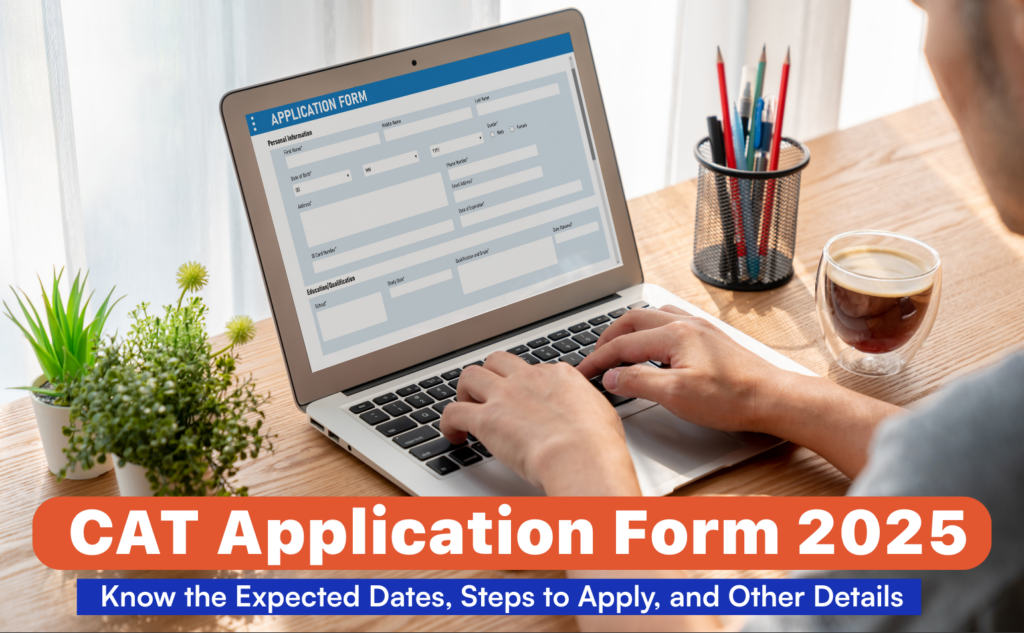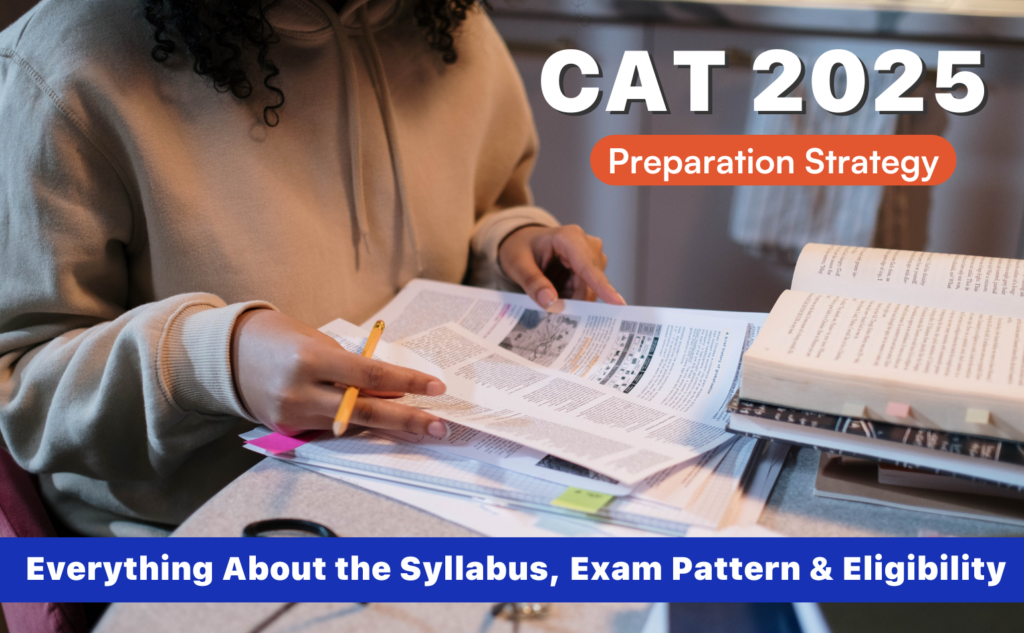If you’re preparing for CAT 2025, you already know how crucial the Verbal Ability and Reading Comprehension (VARC) section is. Among all its components, Reading Comprehension (RC) holds the maximum weight and often, the maximum anxiety for aspirants.
RC passages test more than just your reading speed. They examine how well you comprehend complex ideas, draw inferences, identify tones, and critically evaluate arguments all under tight time constraints. Many students, even those good at grammar and vocabulary, struggle to crack RC due to unfamiliar topics or abstract writing styles.
To understand how important RC is, take a look at the VARC structure of the CAT exam:
| Section | Number of Questions | RC Questions |
| Verbal Ability & Reading Comprehension (VARC) | 24 | 16-18 |
As you can see, RC alone contributes up to 70% of the VARC section making it the most scoring yet challenging part of the verbal paper.
In this blog, we’ll walk you through tried-and-tested CAT RC preparation tips from building your reading habits to mastering tricky inference questions so you can maximize your score in this high-impact area.
Understanding CAT RC: What to Expect
Before diving into preparation strategies, it’s essential to understand what the Reading Comprehension section in CAT actually looks like. Knowing the structure, themes, and question types will help you effectively align your preparation.
Breakdown of RC in CAT VARC Section
- Number of RC Passages: Usually 4 to 5 passages
- Total RC Questions: Around 16 to 18 out of 24 in VARC
- Type of Passages: Moderately to highly complex
- Topics Covered: Philosophy, Science, Sociology, Psychology, History, Abstract Ideas, Environment, Technology
Here’s a snapshot of how RC typically features in the CAT exam:
| Feature | Details |
| Number of RC Passages | 4–5 |
| Questions per Passage | 3–5 |
| Question Types | Passage-based questions (fact-based, inference-based, tone-based, main idea, vocabulary in context, title, logical structure) |
| Passage Length | 350–600 words |
| Difficulty Level | Moderate to High |
| Time Recommended | 30–35 minutes out of 40 mins for VARC |
Skills Tested in RC
CAT RC isn’t about factual recall or memory. It’s about:
- Comprehending dense content quickly
- Identifying the central idea or author’s argument
- Making logical inferences
- Evaluating opposing viewpoints
- Understanding tone, style, and intent
What makes CAT RC unique is its emphasis on logic over knowledge. Even if a passage is from quantum physics or art criticism topics you may not be familiar with, you’ll still be able to answer questions if your comprehension and reasoning skills are sharp.
Why RC is Challenging for Many Students?
Many CAT aspirants find Reading Comprehension difficult—not because they lack intelligence, but because they haven’t built the specific skill set RC demands.
Here are the top reasons students struggle with RC:
- Time Pressure: Reading long, complex passages and answering questions in under 8–9 minutes is tough.
- Unfamiliar Topics: Passages from sociology, psychology, or economics can feel intimidating.
- Complex Sentence Structures: Dense vocabulary and layered ideas slow down understanding.
- Misinterpretation: Students often confuse the author’s tone or intent.
- Inconsistent Reading Habits: Without regular practice, comprehension speed remains low.
The good news? These challenges can be overcome with consistent, innovative preparation, which we’ll cover next.
Daily Reading Habits: The Foundation of RC Prep
If there’s one habit that can transform your RC performance, it’s consistent reading. The CAT RC section is not about speed reading tricks, it’s about developing a profound, focused comprehension ability over time. And the only sustainable way to do that is by reading every day.
Why is Regular Reading Non-Negotiable?
- Builds reading stamina for long passages
- Improves comprehension of unfamiliar or abstract topics
- Increases exposure to different writing styles and tones
- Enhances your vocabulary and contextual understanding
- Makes inference-based and critical reasoning questions easier
The goal isn’t just to read more but to read better. Focused reading of 30 to 45 minutes daily can significantly boost your RC scores.
Sample Weekly Reading Plan for CAT Aspirants
Here’s a simple, high-impact schedule to kickstart your reading habit:
| Day | Source | Type | Goal |
| Monday | The Hindu Editorial | Politics/Society | Identify main arguments and tone. |
| Tuesday | Aeon Essays | Philosophy/Psychology | Practice slow, deep reading |
| Wednesday | The Economist | Economics/Global Affairs | Focus on inference and complex structure |
| Thursday | Harvard Business Review | Business/Leadership | Note author’s intent and logical flow |
| Friday | Scientific American or Nautilus | Science/Tech | Improve comprehension of technical ideas |
| Saturday | Past CAT RC Passage | Mixed | Time-bound practice + review |
| Sunday | Free Reading (Blog, Magazine, etc.) | Any topic | Casual reading + reflection |
Pro Tips for Effective Reading Practice
- Don’t just read and try to summarize the main idea after each article.
- Note unfamiliar words and revisit them regularly.
- Discuss passages with peers or mentors to sharpen interpretation.
- Use an app or notebook to track your reading consistency.
Building this habit takes a few weeks, but once it kicks in, you’ll notice a visible shift in your RC confidence and accuracy.
Reading Strategies to Improve Comprehension
Once you’ve established a consistent reading habit, the next step is refining your reading. The exam is just about reading passages about understanding them deeply, quickly, and accurately.
Below are key strategies that will help you become a more effective RC reader:
1. Skimming vs. Scanning: Know the Difference
| Technique | Purpose | When to Use |
| Skimming | To get the overall idea of the passage | Before reading questions or in the first read |
| Scanning | To locate specific keywords or data | While answering factual/detail-based questions |
Example: While skimming, focus on each paragraph’s first and last sentences—they often carry the main idea.
2. Identify the Central Idea
Every passage has a core argument or thesis. Ask yourself:
- What is the author trying to prove or explain?
- Can I summarise this passage in one line?
Example: If a passage critiques modern education, the central idea might be: “Current education systems suppress creativity and critical thinking.”
3. Understand the Author’s Tone and Intent
Is the tone:
- Neutral?
- Critical?
- Persuasive?
- Satirical?
Recognizing tone helps you avoid trap options in inference and attitude-based questions.
Pro tip: Words like “however,” “unfortunately,” or “remarkably” are tonal markers.
4. Practice Active Reading
Passive reading = low retention. Active reading means:
- Highlighting keywords mentally or on-screen
- Mentally paraphrasing each paragraph
- Asking yourself questions like: “What did I just read?”
5. Avoid Regression (Re-reading)
One of the biggest time-wasters is reading the same sentence multiple times. Avoid this by:
- Reading in chunks (group of 4–6 words)
- Trusting your first read unless the passage is very abstract
6. Use Paragraph Mapping
Break the passage into parts and mentally label them:
- P1: Introduction to the issue
- P2: Historical background
- P3: Current debate
- P4: Author’s conclusion/opinion
This mental structure helps you locate answers faster.
Summary of Key Strategies
| Strategy | Benefit |
| Skimming | Grasp the big picture quickly |
| Central Idea Identification | Improves main idea & title questions |
| Tone Recognition | is Crucial for attitude and inference questions |
| Active Reading | Boosts understanding and retention |
| Paragraph Mapping | Makes navigation and answering faster |
With these techniques, you won’t just read CAT RC passages, you’ll decode them efficiently. Up next: tackling the actual RC questions with precision and speed.
Solving RC Questions: Tips & Tricks
Reading the passage is only half the battle—the real test is answering the questions accurately and quickly. CAT RC questions are designed to challenge your reasoning, not just your memory. Here’s how to tackle them smartly.
Common Types of RC Questions in CAT
| Question Type | What it Tests | Tip to Solve |
| Main Idea | Grasp of the central theme | Focus on intro + conclusion paragraphs |
| Inference | Logical conclusions based on given info | Avoid extreme interpretations. |
| Tone/Attitude | Author’s feelings or stance | Watch out for emotional or judgmental words |
| Title of Passage | Summarizing ability | Pick broad yet accurate titles |
| Vocabulary in Context | Understanding of word usage in a specific setting | Replace the word mentally and check fit |
| Fact-Based | Recall of explicit information | Scan the passage, avoid relying on memory |
| Critical Reasoning | Evaluation of assumptions, flaws, or arguments | Think logically, not emotionally |
Proven Strategy to Solve RC Questions
- Read the passage first – unless you’re already very familiar with the topic, don’t jump to questions directly.
- Note key points mentally – especially in the first and last paragraphs.
- Approach questions logically – eliminate clearly wrong or extreme options.
- Return to the passage for confirmation—don’t rely on guesswork unless it is time-bound.
- Avoid emotional judgment – base your answers on the author’s view, not your own.
Time Management During RC in CAT
| Activity | Recommended Time |
| Reading a Passage | 3.5 – 4.5 minutes |
| Answering Questions (4–5 | 4 – 5 minutes |
| Total Time per Passage | 8 – 9 minutes |
| RC Section (4 Passages) | 30 – 35 minutes |
How to Eliminate Trap Options
- Avoid extreme qualifiers like always, never, and completely—CAT prefers balanced answers.
- Pick the one closest to the passage’s wording if two options seem correct.
- Don’t pick options based on general knowledge or assumptions.
Practice Tip: RC Journaling
Maintain a notebook or digital log where you:
- Record the type of passage
- Note questions you got wrong
- Identify the reason (misinterpretation, vocabulary, careless reading)
- Reflect weekly on your improvement areas
Common Mistakes to Avoid in RC Preparation
Even diligent students sometimes find their RC scores stagnating. Often, it’s not due to lack of effort but to avoidable mistakes that go unnoticed. Here are the most common errors to watch out for:
1. Neglecting RC in Favor of Grammar or Vocabulary
While grammar and vocabulary are essential, RC dominates the VARC section with 16–18 questions. You’re missing the real scoring opportunity if you focus only on word lists or grammar rules.
2. Relying on Instinct Instead of Logic
Many aspirants “go with their gut” while answering RC questions. But CAT RC is a logical reasoning test in disguise—your answers must be rooted in the passage, not your personal opinion or general knowledge.
3. Ignoring Explanation of Wrong Answers
After practice, students often only check how many questions they got right. But real learning happens when you analyze your wrong answers:
- Why was the correct option better?
- Was your misjudgment due to tone, logic, or haste?
4. Skipping Reading Practice
You can’t “hack” RC with shortcuts. If you’re not building a regular reading habit (as discussed earlier), your comprehension speed will plateau no matter how many questions you solve.
5. Avoiding These Mistakes = Faster Improvement
Making these small but impactful changes can significantly boost your accuracy, confidence, and consistency in RC performance.
Expert Tips for Non-English Background Students
If English isn’t your first language, Reading Comprehension in CAT can seem incredibly challenging. The dense vocabulary, abstract topics, and academic tone may initially feel overwhelming. But here’s the truth—you don’t need to be a fluent speaker to ace RC.
With the right approach, even students with a non-English background can score exceptionally well in RC. Here’s how:
1. Start with Simple, Short Reads
Don’t dive into The Economist or philosophy essays right away. Start with:
- Editorials from The Indian Express or The Hindu
- Short, well-written blogs or articles on Quora, Medium
- Children’s books (e.g., National Geographic for Kids) to build reading ease
Gradually transition to longer and more complex reads.
2. Maintain a Personal Vocabulary Journal
Write down:
- Unfamiliar words
- Their meanings in your native language
- A sample sentence of your own
Review this list once a week. Over time, your vocabulary will grow without conscious memorization.
3. Listen to English Podcasts and News
This improves your understanding of:
- Pronunciation
- Sentence structure
- Tone and emphasis (helpful in RC tone-based questions)
Recommended Podcasts:
- BBC Learning English
- The Daily (NYT)
- Freakonomics Radio
4. Translate & Summarize Passages
After reading an article:
- Try summarizing it in your native language
- Then, translate it back into English in your own words
This helps build comprehension and expression, which are key for RC accuracy.
5. Don’t Fear Mistakes
Many learners hesitate or self-censor. But every error is a learning opportunity. Focus on progress, not perfection.
- RC doesn’t reward fancy words, it rewards clear understanding within your reach.
With these steps, even students who aren’t comfortable with English initially can outperform fluent speakers simply by being methodical and persistent.
Conclusion & Final Takeaways
Reading Comprehension doesn’t have to be the most dreaded part of CAT. With the proper habits, strategic practice, and thoughtful analysis, it can become a high-scoring section especially for those who invest in consistency.
Let’s recap the key takeaways:
- Start building daily reading habits, read diverse articles to improve adaptability
- Use proven strategies like skimming, paraphrasing, and paragraph mapping
- Practice regularly with CAT-level resources, timed drills, and detailed reviews
- Avoid common mistakes like skipping analysis or relying on guesswork
- Use tailored tips if you’re from a non-English background—your progress matters
Final Tip
RC is less about knowing everything and more about thinking critically under pressure. Treat every practice passage as an opportunity to train your mind for the exam.
Need Structured Guidance?
At Tarkashastra, we don’t just give you theory, we walk with you through:
- Curated RC drills with mentor feedback
- Mock test simulations and analysis
- Personalized improvement plans based on your strengths and weaknesses
Ready to master CAT RC the smart way? Visit Tarkashastra’s CAT Coaching Page to get started!
Frequently Asked Questions
1. What Is Reading Comprehension (RC) in CAT?
Reading Comprehension (RC) is part of the CAT exam’s VARC (Verbal Ability and Reading Comprehension) section. RC passages are typically 350–600 words long and are followed by 3–5 questions that test your ability to understand, analyze, and interpret the content. Topics can vary from science and philosophy to politics and business.
2. How Important Is RC in the CAT Exam?
RC is essential, as it forms the bulk of the VARC section—typically 16–18 out of 24 questions. That means nearly two-thirds of your VARC score depends on how well you handle RC. A strong performance in RC can significantly boost your overall CAT percentile.
3. How Many RC Questions Are Typically Asked in the CAT Exam?
You can expect around 4–5 RC passages in the CAT exam, with 16 to 18 questions based on those passages. Each passage usually has 3 to 5 associated questions, covering various types like main idea, inference, tone, and vocabulary in context.
4. What Is the Time Duration Allotted for RC Questions in CAT?
The total time for the VARC section is 40 minutes (for non-PwD candidates). Ideally, you should allocate 30–35 minutes for RC passages, which translates to about 8–9 minutes per passage, including reading and answering all associated questions.
5. What Are the Key Strategies to Improve in CAT RC?
- Build a daily reading habit from diverse sources
- Practice active reading, note the main idea, tone, and flow
- Improve vocabulary through contextual learning
- Use paragraph mapping to track the structure
- Practice both timed and untimed RCs
- Analyze wrong answers to identify weak areas
6. How Can I Increase My Reading Speed for RC?
You can improve your reading speed by:
- Practicing skimming and scanning techniques
- Reading for idea chunks (4–6 words at a time)
- Reducing regression (avoiding re-reading unless necessary)
- Building stamina through 30–45 minutes of daily reading
- Tracking time during practice sessions to gradually speed up
7. What Are Some Useful Tips for Reading RC Passages More Effectively?
- Skim the first and last paragraphs to understand the theme
- Identify transition words to follow the author’s logic
- Understand the tone and intent of the author
- Don’t get stuck on tricky words—focus on the overall meaning
- Mentally paraphrase after each paragraph to retain key ideas
8. How Should I Approach Solving RC Passages During the CAT Exam?
- Read the passage thoroughly first, unless the questions are direct
- Start with the main idea or tone-based questions, then move to factual ones
- Use the elimination method for tricky options
- Don’t overthink, stick to what’s stated or implied in the passage
- If unsure, mark and move—come back later if time permits







